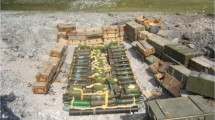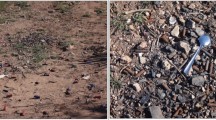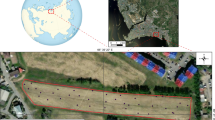Abstract
Studies on heavy metal contamination in soils used for ammunition disposal and destruction are still emerging. The present study aimed to evaluate the contamination level and spatial distribution of lead in disposal and destruction areas. This site was used for ammunition disposal and destruction activities for 20 years. The ammunition destruction site (1,296 ha), a sampling system that followed a sampling grid (5 m × 5 m) with 30 points was adopted and samples were collected at the following five depths with a total of 150 samples. During the collection procedure, each sampling grid point was georeferenced using a topographic global positioning system. Data were validated through semivariogram and kriging models using Geostat software. The results demonstrated that the average lead value was 163 mg kg−1, which was close to the investigation limit and the contamination levels were higher downstream than upstream. The results showed that there was lead contamination at the destruction site and that the contamination existed mainly at the surface layer depth. However, high lead concentrations were also found at deeper soil depths in the destruction area due to frequent detonations. According to the planimetry data, the areas that require intervention significantly decreased with increasing depths in the following order: 582.7 m2 in the 0–20 cm layer; 194.6 m2 in the 20–40 cm layer; 101.6 m2 in the 40–60 cm layer; and 45.3 m2 in the 60–80 cm layer.



Similar content being viewed by others
References
Al-Khashman OA, Shawabkeh RA (2009) Metal distribution in urban soil around steel industry beside Queen Alia Airport, Jordan. Environ Geochem Health 31:717–726
Amaral Sobrinho NMB, Barra CM, Lã RO (2009) In: Melo VF, Alleoni LRF (eds) Química e mineralogia do solo. SBCS, Viçosa, pp 249–312
Brum T (2010) Remediação ambiental de áreas contaminadas por explosivos. Master Science Thesis, Instituto Militar de Engenharia, Rio de Janeiro
Cao X, Ma LQ, Chen M, Hardison DW, Harris WG (2003) Lead transformation and distribution in the soils of shooting ranges in Florida, USA. Sci Total Environ 307:179–189
Conselho Nacional de Meio Ambiente (CONAMA) (2005) Ministry of environment resolution n 357, 17 March 2005
Conselho Nacional de Meio Ambiente (CONAMA) (2009) Ministry of environment resolution n 420, 28 Dec 2009
Gringarten E, Deutsch CV (2001) Teacher’s aide: variogram interpretation and modeling. Math Geol 33(4):507–534
Huang ZY, Chen T, Yu J, Qin DP, Chen L (2011) Lead contamination and its potential sources in vegetables and soils of Fujian, China. Environ Geochem Health 34:55–65
ISO 11466 (1995) International organization for standardization: soil quality—extraction of trace elements soluble in aqua regia, Geneva, 03–01
Li LY (2006) Retention capacity and environmental mobility of Pb in soils along highway corridor. Water Air Soil Pollut 170(1–4):211–227
Li Y, Wong CP (2006) Recent advances of conductive adhesives as a lead-free alternative in electronic packaging: materials, processing, reliability and applications. Mater Sci Eng 51(1–3):1–35
Luo XS, YuS LiXD (2011) Distribution, availability and sources of trace metals in different particle size fractions of urban soils in Hong Kong: implications for assessing the risk to human health. Environ Pollut 159:1317–1326
McGrath D, Zhang C, Carton OT (2004) Geostatistical analyses and hazard assessment on soil lead in Silvermines area, Ireland. Environ Pollut 127:239–248
Silva EF, Zhang C, Pinto LS, Patinha C, Reis P (2004) Hazard assessment on arsenic and lead in soils of Castromil gold mining area, Portugal. Appl Geochem 19:887–898
Vieira SR (2000) In: Borem A, Giudice MP, Queiroz DM, Mantovani EC, Ferreira LR, Valle FXR, Gomide RL (eds) Geoestatística Aplicada à Agricultura de Precisão. Agricultura de Precisão, Viçosa, pp 93–108
Webster R (2008) Soil science and geostatistics. In: Krasilnikov P, Carré F, Montanarella L (eds) Soil geography and geostatistics: concepts and applications. JRC-IES, Ispra, pp 1–11
Webster R, Oliver MA (2001) Geostatistics for environmental scientists. Wiley, Chichester
World Health Organization (2010) Exposure to lead: a major public health concern. Geneva, Available via http://www.who.int/ipcs/features/lead.pdf. Accessed 12 Dec 2011
Author information
Authors and Affiliations
Corresponding author
Rights and permissions
About this article
Cite this article
do Nascimento Guedes, J., do Amaral Sobrinho, N.M.B., Ceddia, M.B. et al. Concentration and Spatial Distribution of Lead in Soil Used for Ammunition Destruction. Bull Environ Contam Toxicol 89, 775–781 (2012). https://doi.org/10.1007/s00128-012-0790-9
Received:
Accepted:
Published:
Issue Date:
DOI: https://doi.org/10.1007/s00128-012-0790-9




